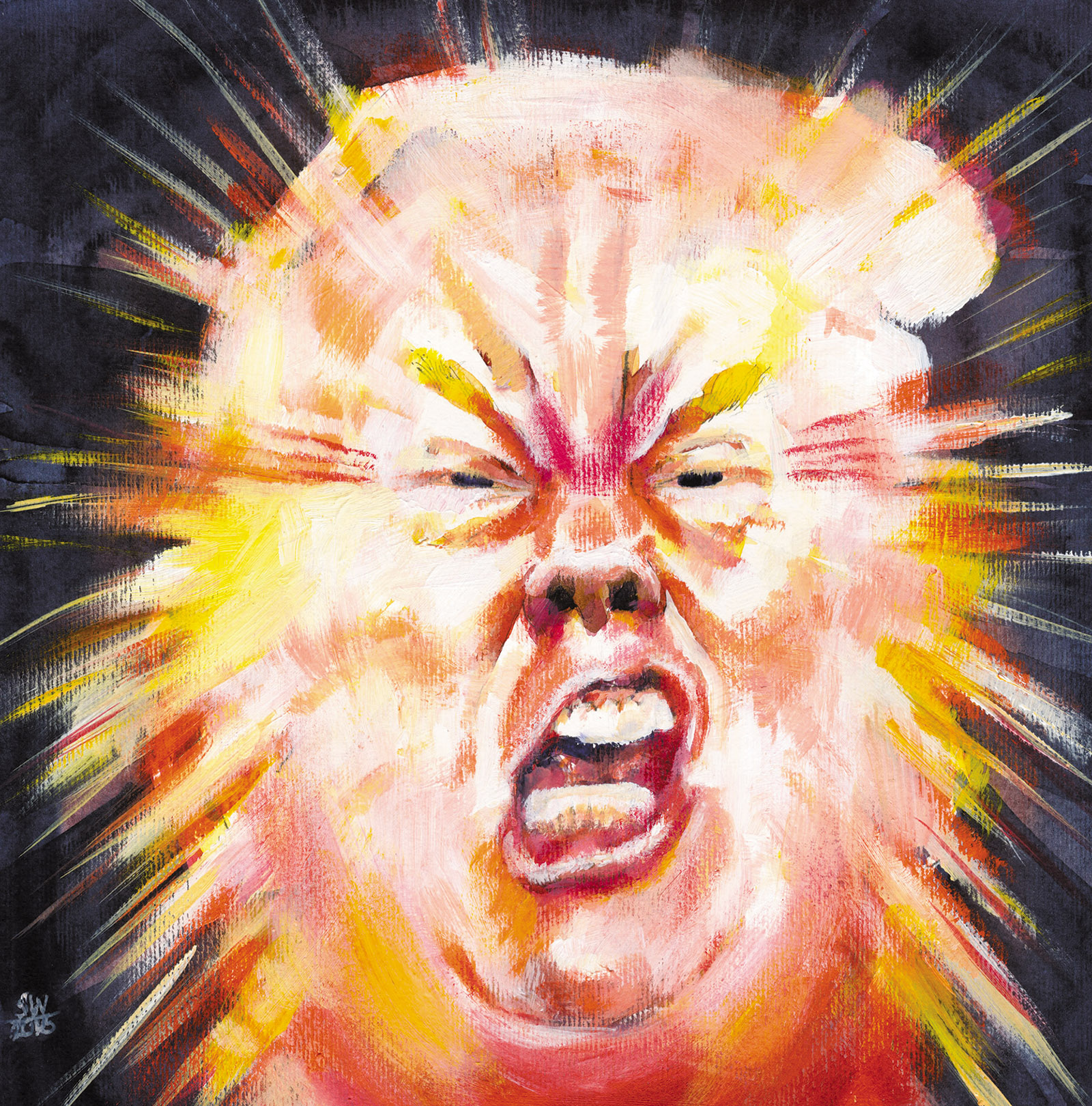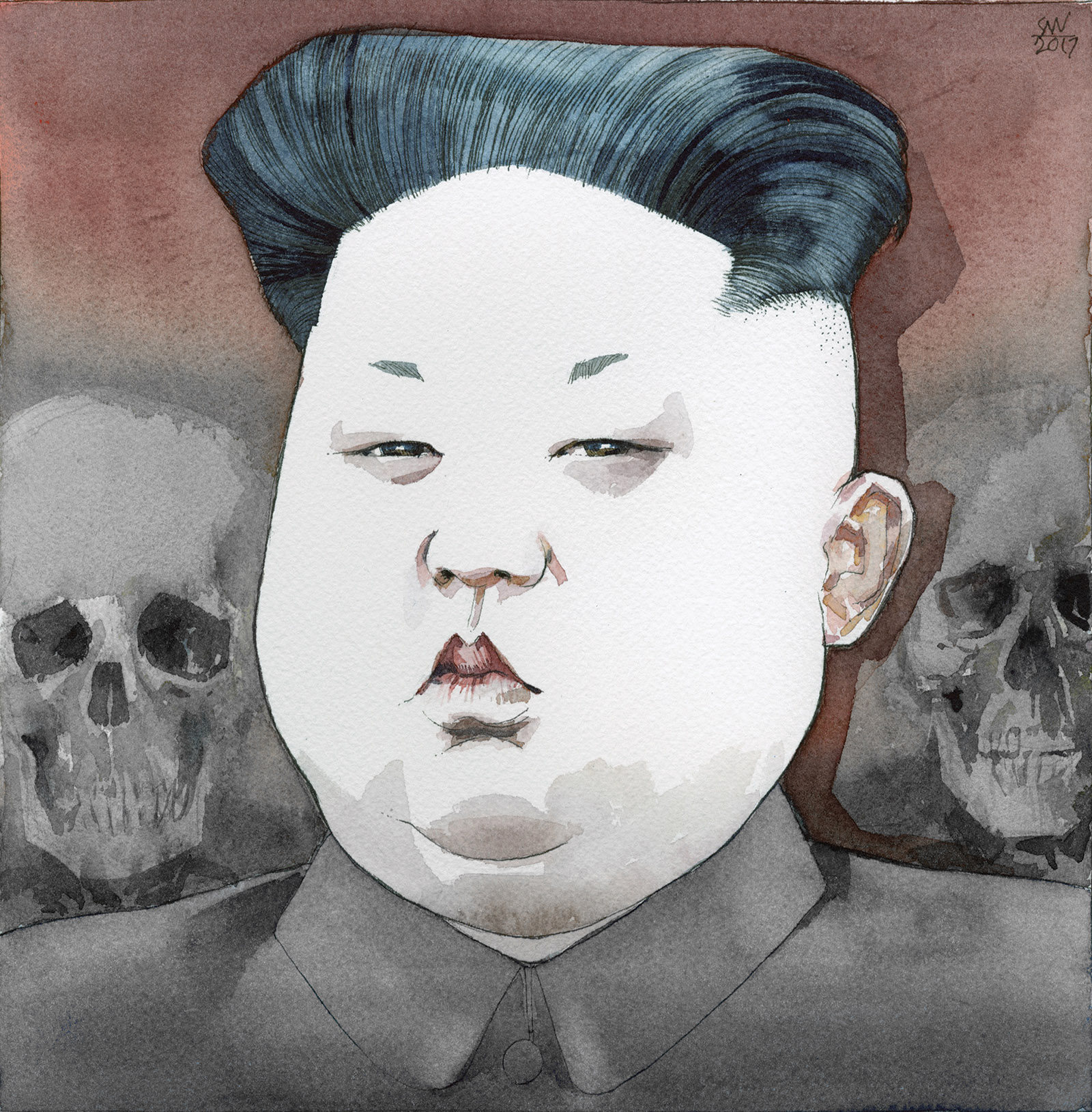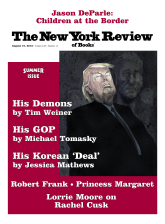There are two possibilities: either President Trump was as ignorant after his June 12 meeting with Kim Jong-un about what North Korea has in mind when it pledges “complete denuclearization of the Korean Peninsula” as he was in March when he brushed aside warnings from his aides and rushed to accept Kim’s invitation to meet. This would mean that in the intervening three months he learned nothing about the past quarter-century of failed efforts to stop North Korea’s nuclear program and genuinely believes he accomplished something in Singapore.
Or the president knows that he got nothing. In that case, when he bragged on his way home that “this should have been done years ago” and later tweeted “There is no longer a Nuclear Threat from North Korea,” he was simply being fraudulent in the way that works so well for him at home. Stripped of its made-for-TV trappings—the walk, the flags, the solemn handshake, and the breathless talk of history being made—nothing was actually agreed to at the summit. Evidence that there had, in fact, been no meeting of the minds came with whiplash speed. In just over three weeks North Korea was accusing the US, which had not changed its position, of “gangster-like” demands. Call it Fake Diplomacy.
Which is more dangerous—someone so convinced of his abilities and so lazy that he would walk into such a negotiation without knowing even the tiny bit of history (sketched in the box at the bottom of this page), or someone willing to offer the world a bald-faced lie? Someone who doesn’t try, or someone who doesn’t care about the actual outcome as long as he can sell a short-lived story of personal success and move on?
Unpreparedness risks costly mistakes, such as the ones Trump made at this meeting. Bluster and sloppy, unthinking language risk being misinterpreted by both adversaries and allies as being serious when it isn’t or, worse, brushed aside as a bluff when it isn’t. Historians still debate how great an effect Secretary of State Dean Acheson’s speech placing South Korea outside the US defense perimeter had on the decision made by Kim Il Sung, Stalin, and Mao to launch the Korean War in 1950.
The phrase “complete denuclearization of the Korean Peninsula,” which got Trump so excited back in March and which he continues to mistranslate as “they are willing to de-nuke,” was, as the box reveals, first used by North Koreans twenty-six years ago. To them, it has always meant that North Korea would denuclearize after the United States walks away from its defense alliance with South Korea, removes its troops from the Korean Peninsula, withdraws the nuclear umbrella that now deters an invasion of South Korea, signs a peace treaty to end the Korean War, removes nuclear-capable weapons (or perhaps its entire presence) from an undefined perimeter of Northeast Asia, and ends other “anti-DPRK hostile policies,” presumably including economic sanctions. All of this is captured in the phrase “phased, synchronized” denuclearization used by South Korea and China in their meeting before the Singapore summit. Complete denuclearization can also mean to North Korea that as the world’s ninth nuclear state—as it now considers itself—it will denuclearize when the other eight do so—at best an unlikely event that lies decades in the future. Either way, in practical terms, the phrase, on its own, means nothing.
The brief joint statement issued at the end of the Singapore summit did not put a toe over the line established in North Korea’s many prior agreements with the US, with South Korea, and in several rounds of Six-Party Talks (South Korea, North Korea, the US, China, Japan, and Russia). Every one of these was meaningless at the time of its writing (as in 1992, when North Korea agreed not to possess reprocessing plants, even as it was building such a plant) or was cheated on later by Pyongyang. Where the new document does not exactly repeat earlier wording, its language is mushier. This time, for example, North Korea commits “to work toward complete denuclearization of the Korean Peninsula” (emphasis added)—one step backward from earlier commitments and a measure by which it is impossible to fail.
Most importantly, the document contains no actual substance—as did the 1994 Agreed Framework, which halted North Korea’s plutonium production (and on which it later cheated), or the 2005 Six-Party agreement (which came to nothing). Secretary of State Mike Pompeo clearly knew he was on shaky ground when a reporter probed about the lack of any reference to verification. With no answer to offer, he attacked the question as “insulting and ridiculous and, frankly, ludicrous.” Commentators in Singapore endlessly repeated that “the details” would be filled in by Pompeo and a North Korean counterpart, but there is no content to detail. If the rationale for a summit was that only heads of state could break through the lack of trust that prevents lower-level negotiators from succeeding, it proved to be ill-founded. The Pompeo process started in the same place as prior efforts.
Advertisement
More accurately, because of rash concessions made by Trump at the meeting, Pompeo started in a hole, facing emboldened adversaries, and with shaken allies at his back. Failing to make meaningful progress with North Korea is no shame, and there is no question that talking is an improvement over escalating threats of war. But without getting anything from North Korea, Trump gave and gave. Whether from impulsiveness or ignorance, he produced real losses for American security and that of South Korea and Japan.
Meeting with a sitting US president was a goal Pyongyang had sought for decades. Trump gave it for free. Rather than remaining silent on North Korea’s human rights record in the interest of reaching an agreement, Trump needlessly chose to make light of it, terming North Korea “rough” and adding, “It’s rough in a lot of places.” For good measure, he wrapped Kim in just about every warm adjective he could find: nice, funny, really smart, worthy, one in 10,000, very talented, loves his people, and so on. (If Trump believes that Kim is as susceptible to flattery as he is himself, he will likely soon discover his error.)
Despite Trump’s own low standing in the world, the net result of a meeting, as equals, between the leader of North Korea and the United States, and the praise lavished before a global audience on Kim, was to legitimize a man and a regime known for totalitarian rule, a disastrous economy, and an appalling record of human rights abuses, and to immeasurably raise their status worldwide. The seal of US approval so lavishly dispensed—Trump even dangled an invitation to the White House—at least undermines and, more likely, destroys any possibility of returning to widely supported sanctions of “maximum pressure.”
Trump also weakened America’s military leverage—again without receiving anything in return. He called the defensive military exercises the US and South Korea jointly run twice each year “war games” and for good measure adopted the exact phrase North Korea uses to describe them—“provocative.” He suspended the exercises indefinitely beginning this August, and did so without consulting Seoul. He also said that he’d like to withdraw all American forces from South Korea.
Kim must have been stunned by the rain of unreciprocated gifts. In Beijing, Xi Jinping too got more than he could have hoped for: withdrawal of American pressure that threatened to destabilize North Korea; removal of the pressure on him to crack down on Pyongyang; and further evidence, in Trump’s desire to remove US troops from Korea, of a waning American commitment to leadership in Asia, which had already been indicated by Washington’s withdrawal last year from its pan-Asian trade agreement, the Trans-Pacific Partnership. Tokyo’s dismay and Seoul’s shocked reaction to news of the unilateral US decision to suspend military exercises are evidence that Xi can easily interpret as yet another fissure in the once-solid bulwark of US alliances in the Pacific. As Xi spends hundreds of billions to woo allies around Asia, most of them poor, he can only be shaking his head in amazement at the spectacle of the American president complaining that his allies—after China, by far the two strongest states in the region—cost him too much.
Setting aside the unforced errors of the Singapore meeting, this latest episode in the twenty-five-year effort to roll back North Korea’s nuclear program invites a rethinking of American strategy. Washington’s announced objective was “complete, verifiable and irreversible denuclearization.” After the meeting, Secretary Pompeo insisted that he was “hopeful that we can achieve” “major disarmament” by the end of the president’s term—that is, in two and a half years. North Korea understands, he added, that a deal would require “in-depth verification.” How likely is any of this?
Many countries have given up a nuclear weapons program at various stages of progress, including South Korea, Taiwan, Sweden, Brazil, Argentina, Egypt, Romania, Libya, Iraq, and Iran. Canada, Belarus, Kazakhstan, and Ukraine have given up weapons they inherited or obtained from others. Only one country—South Africa—has given up completed weapons it made itself. F.W. de Klerk’s apartheid government destroyed its six nuclear weapons in 1990, shortly after it released Nelson Mandela from prison and lifted the ban on the African National Congress. Whether the motive was a commitment to nonproliferation or—more likely—an unwillingness to hand nuclear weapons to an incoming black government is uncertain. What one can say with certainty is that this act is extremely rare.
Advertisement
Experience and common sense say that the more a country has invested economically and psychologically in a nuclear weapons program, the longer it has worked on it, and the closer it gets to success, the harder the program becomes to give up. Actual weapons are the most difficult to surrender, even under severe external pressure. The degree to which a country believes it faces an existential threat is critical from beginning to end. By all these measures, North Korean disarmament is extremely unlikely. Its program began more than half a century ago, in 1962. It suffered devastating destruction in the Korean War, still in the living memory of many. Officially, it is still at war with the greatest power on earth. Its extreme isolation and its propaganda machine feed paranoia. It has sacrificed mightily and succeeded greatly in making a large nuclear arsenal that it calls “treasured sword.”
Moreover, disarmament is meaningless without verification, which is a special challenge for Pyongyang. As a first step, verification requires full disclosure of a country’s weapons, materials, and facilities. These must then be inspected and continuously monitored. Inspectors must be allowed to search for undisclosed sites. North Korea, perhaps the world’s most reclusive country, has never even acknowledged facilities beyond a single site, though well over a dozen others are known to exist. Verifiable disarmament is thus a very distant hope. Even verifiable cuts in the number of warheads, stockpiles of weapons fuel, missile forces, and the operations of reprocessing and enrichment plants will be difficult to achieve.
North Korea’s well-established pattern is to ratchet up tension—as it did in 2017 through a string of nuclear and missile tests—and then pause (or appear to pause as secret activities continue) to see what it can get in negotiations. This appears to be where we are now with the moratorium on testing that Kim announced several months ago (see the box below for his April remarks to the Central Committee). Talks then continue for months or years with growing acrimony and mutual charges of bad faith until they end in gridlock or the discovery of cheating by North Korea on an existing commitment. That this familiar stage came just three weeks after the Trump–Kim summit reveals how illusory its supposed agreement was.
It is time the US stops misleading itself by defining success as disarmament achieved in the near future. If it can ever be achieved—and the chances are slim—it will come at the end of a many-stage process over a great many years, when North Korea is a more confident, less isolated, and hence less belligerent country than it is today. For now, a new pattern should be established by the US and other negotiating partners that sets less ambitious goals on which cheating can be immediately detected and made visible to the world. Restrictions should be confined to what can be absolutely verified from outside the country: weapons tests, missile tests, and exports of nuclear materials and know-how. This is far from disarmament or even a rollback. It would amount only to a partial standstill.
For such a strategy to be successful, concessions made to North Korea have to be strictly rationed at each stage or leverage will be exhausted long before negotiations reach the heart of the problem. This is why Trump’s largesse in Singapore was such an error. He gave far too much for almost nothing: continuation of an existing testing moratorium, unmonitored destruction of possibly useless testing sites, and a willingness to continue talking.
In retrospect, it was too optimistic to hope that Trump’s first experience of the difficulties of constructing an international agreement would lead him and his team to take a second look at what they are throwing away in the Iran deal, which dwarfs what has ever been agreed to with North Korea. He is simply too practiced at skimming the surface of complex issues and convincing himself of whatever he wants to believe. Perhaps the best hope for this summit’s eventual outcome is that, like its many predecessors, it will gradually dissolve in deadlocked negotiations. Then it will be time to start again: this time with preparation and realistic expectations. Meanwhile, it stands as a sobering reminder to the world that the current American president is capable of treating even war-and-peace diplomacy as performance art in the interest of personal, rather than national, benefit.
—July 18, 2018
A PARTIAL LIST OF DPRK NUCLEAR UNDERTAKINGS
| Between North and South Korea | |
| 1992 | Both sides commit to “complete denuclearization of the Korean Peninsula”; not to build or receive nuclear weapons; not to possess reprocessing and enrichment facilities; and to jointly inspect agreed locations. |
| 2007 | Calls for a “permanent peace regime” and economic cooperation between the two Koreas. |
| 2018 | Calls for “a permanent and solid peace regime” and “the common goal of realizing, through complete denuclearization, a nuclear-free Korean Peninsula.” |
| Between North Korea and the US | |
| 1993 | North Korea’s planned withdrawal from the Non-Proliferation Treaty (NPT), announced earlier that year, is paused; agreement to remain in the NPT includes “assurances against the use of force,” a commitment to “peace and security in a nuclear free Korean Peninsula,” and support for peaceful reunification. |
| 1994 | The Agreed Framework: North Korea to freeze plutonium production and subject facilities to international inspection. The US to supply fuel oil and safer reactors for electricity. Agreement to move toward “full normalization of political and economic relations” and to “work together for peace and security on a nuclear-free Korean peninsula.” |
| 2000 | North Korea to suspend launches of “long-range missiles of any kind” while talks continue. Mentions ways to “reduce tension on the Korean Peninsula and formally end the Korean War by replacing the 1953 Armistice Agreement with permanent peace arrangements” and declares that neither side has “hostile intent” toward the other. |
| 2012 | A “moratorium” on various nuclear activities with verification measures. Food aid and other assurances of “no hostile intent” and commitment to “peace and stability on the Korean Peninsula.” |
| Multilateral | |
| 2003 | North Korea withdraws from the NPT. |
| 2005 | Fourth Round of the Six-Party Talks proclaims the shared goal of “the verifiable denuclearization of the Korean Peninsula.” North Korea commits to “abandoning all nuclear weapons and existing nuclear programs and returning, at an early date,” to the NPT and International Atomic Energy Agency inspections and safeguards. |
| Unilateral Statements | |
| 2003 | The Party Central Committee says that North Korea’s nuclear weapons “are not goods for getting US dollars and they are neither a political bargaining chip nor a thing… [to] be put on the table of negotiations aimed at forcing the DPRK to disarm itself.” |
| 2018 | Kim Jong-un reports to the Central Committee on “the miraculous victory of having perfectly accomplished the historic cause of building the state nuclear force.” Therefore, he says, “a fresh climate of détente and peace is being created…and dramatic changes are being made in the international political landscape.” (April) |
| Adapted from Joshua Pollack, “Denuclearization of the Korean Peninsula: Reviewing the Precedents,” Arms Control Wonk blog, June 10, 2018. | |
This Issue
August 16, 2018
The ‘Witch Hunters’
The American Nightmare
The Queen of Rue





